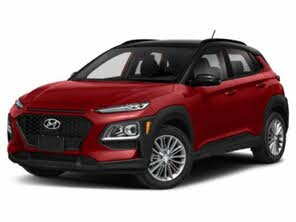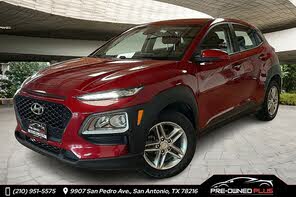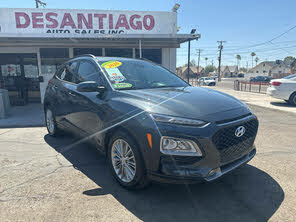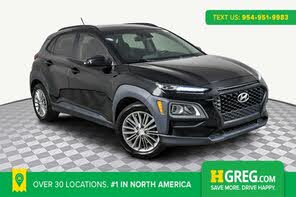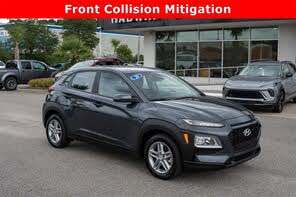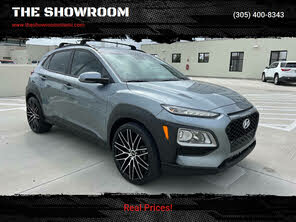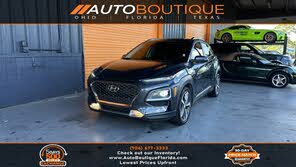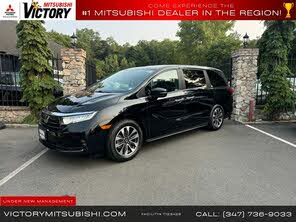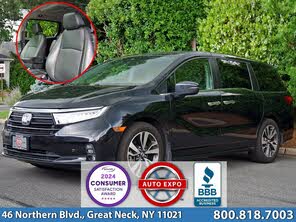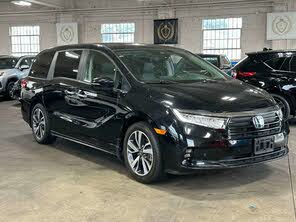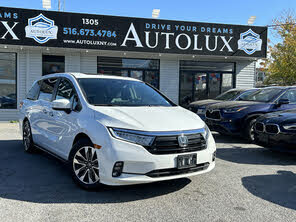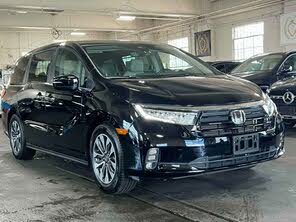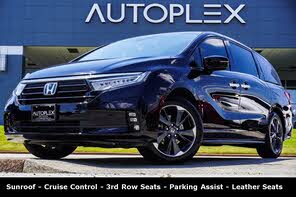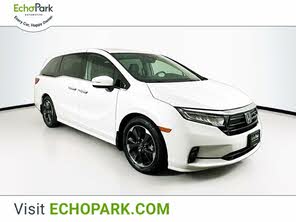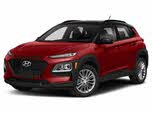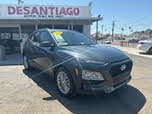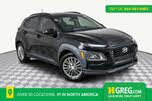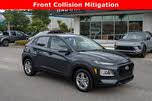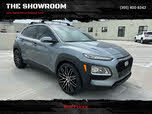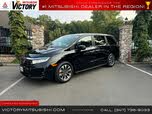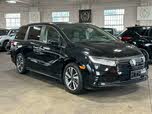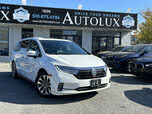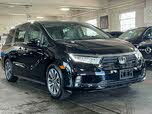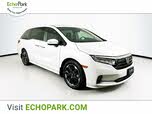2020 Hyundai Kona vs 2021 Honda Odyssey
Overview | |
MSRP$20,300 | MSRP$31,790 |
Average price$17,259 | Average price$30,305 |
Listings440 | Listings432 |
Ratings & Reviews | |
User Reviews | User Reviews |
Expert reviews6.8 out of 10 | Expert reviews7.8 out of 10 |
Pros
| Pros
|
2020 Hyundai Kona Reviews SummaryThe Hyundai Kona subcompact SUV is one of the smallest cars you can buy with all-wheel drive. It competes in a class of four-door hatchbacks with the lifted suspensions and higher driving positions that crossover buyers want—and with the same generous list of convenience and safety features that come on larger crossovers. We last tested the Kona when it came out for 2018, but a new trim level and more standard driver assists are the major changes for 2020. For what Hyundai charges, the Kona is cramped and the interior disappoints, yet exterior style and on-road performance are spectacular. | |
2021 Honda Odyssey Reviews SummaryWhen you’re raising kids, the last thing your life needs is added complication. The modern minivan is designed to eliminate snags, simplify your existence, and reduce friction in the daily grind. Whether you wish to save money on gas, carry maximum cargo, or own a vehicle that is ridiculously easy to load (whether we’re talking passengers or merchandise), a minivan makes good sense. And the freshened 2021 Honda Odyssey is one of our favorites, for now. | |
Popular Features & Specs | |
Engine2.0L 147 hp I4 | Engine3.5L 280 hp V6 |
Drive TrainFWD | Drive TrainFWD |
Seating Capacity5 | Seating Capacity7 |
Horsepower147 hp @ 6200 rpm | Horsepower280 hp @ 6000 rpm |
MPG City27 | MPG City19 |
MPG Highway33 | MPG Highway28 |
Engine | |
Engine Name2.0L 147 hp I4 | Engine Name3.5L 280 hp V6 |
Torque132 lb-ft @ 4500 rpm | Torque262 lb-ft @ 4700 rpm |
Horsepower147 hp @ 6200 rpm | Horsepower280 hp @ 6000 rpm |
DrivetrainFWD | DrivetrainFWD |
Fuel Economy | |
MPG City27 | MPG City19 |
MPG Highway33 | MPG Highway28 |
Interior | |
Seating Capacity5 | Seating Capacity7 |
Safety | |
Front Crash Overall5 | Front Crash Overall5 |
Side Crash Overall5 | Side Crash Overall5 |
Dimensions & Capacity | |
Cargo Space19.2 cu ft | Cargo Space32.8 cu ft |
Curb Weight2890 lbs | Curb Weight4398 lbs |
Height61.0 in | Height68.3 in |
Length164.0 in | Length205.2 in |
Width70.9 in | Width92.3 in |
Wheelbase102.4 in | Wheelbase118.1 in |
Maximum Payload1089 lbs | Maximum Payload1621 lbs |
Number of doors4 | Number of doors4 |
Maximum Towing Capacity | Maximum Towing Capacity3500 lbs |
Overview | ||
MSRP | $20,300 | $31,790 |
Average price | $17,259 | $30,305 |
Listings | ||
Ratings & Reviews | ||
User reviews | ||
Expert reviews | 6.8 out of 10Read full review | 7.8 out of 10Read full review |
Pros & cons | Pros
| Pros
|
Summary | The Hyundai Kona subcompact SUV is one of the smallest cars you can buy with all-wheel drive. It competes in a class of four-door hatchbacks with the lifted suspensions and higher driving positions that crossover buyers want—and with the same generous list of convenience and safety features that come on larger crossovers. We last tested the Kona when it came out for 2018, but a new trim level and more standard driver assists are the major changes for 2020. For what Hyundai charges, the Kona is cramped and the interior disappoints, yet exterior style and on-road performance are spectacular. | When you’re raising kids, the last thing your life needs is added complication. The modern minivan is designed to eliminate snags, simplify your existence, and reduce friction in the daily grind. Whether you wish to save money on gas, carry maximum cargo, or own a vehicle that is ridiculously easy to load (whether we’re talking passengers or merchandise), a minivan makes good sense. And the freshened 2021 Honda Odyssey is one of our favorites, for now. |
Video | ||
Popular Features & Specs | ||
Engine | 2.0L 147 hp I4 | 3.5L 280 hp V6 |
Drive Train | FWD | FWD |
Seating Capacity | 5 | 7 |
Horsepower | 147 hp @ 6200 rpm | 280 hp @ 6000 rpm |
MPG City | 27 | 19 |
MPG Highway | 33 | 28 |
Engine | ||
Engine Name | 2.0L 147 hp I4 | 3.5L 280 hp V6 |
Torque | 132 lb-ft @ 4500 rpm | 262 lb-ft @ 4700 rpm |
Horsepower | 147 hp @ 6200 rpm | 280 hp @ 6000 rpm |
Drivetrain | FWD | FWD |
Fuel Economy | ||
MPG City | 27 | 19 |
MPG Highway | 33 | 28 |
Interior | ||
Seating Capacity | 5 | 7 |
Safety | ||
Front Crash Overall | 5 | 5 |
Side Crash Overall | 5 | 5 |
Dimensions & Capacity | ||
Cargo Space | 19.2 cu ft | 32.8 cu ft |
Curb Weight | 2890 lbs | 4398 lbs |
Height | 61.0 in | 68.3 in |
Length | 164.0 in | 205.2 in |
Width | 70.9 in | 92.3 in |
Wheelbase | 102.4 in | 118.1 in |
Maximum Payload | 1089 lbs | 1621 lbs |
Number of doors | 4 | 4 |
Maximum Towing Capacity | 3500 lbs | |
The 2020 Hyundai Kona had a visually stimulating exterior that stood out in its segment. It featured tiered lighting, a tall grille, and chunky matte plastic trim, making it appear taller and wider than it actually was. The design included slim LED running lamps, headlights spaced to the car's edges, and optional fog lights, creating a sleek and sporty look. The fender creases, black trim, and two-tone wheels added to its premium vibe. However, the interior did not match the exterior's quality, with hard plastics and lackluster finishes. Despite some good features like high-res screens and acceptable layout, the Kona's interior fell short compared to competitors like the Mazda CX-30 and Honda HR-V.
In contrast, the 2021 Honda Odyssey had a familiar look with minor tweaks for modernization. It featured a new grille and front bumper, standard LED headlights with automatic high-beam operation, and a gloss black spear with a chrome insert stretching the width of the taillights. New wheel designs debuted for the top three trim levels, reducing brightwork and giving the Odyssey a more contemporary appearance. The Elite trim included perforated leather upholstery with contrast stitching and piping, new dashboard ambient lighting, and handsome 19-inch wheels with Shark Gray paint and machined surfaces, enhancing its upscale look and feel.
The 2020 Hyundai Kona offered a standout powertrain with its 1.6-liter turbocharged inline-four engine, producing 175 horsepower and 195 pound-feet of torque. This engine, paired with a 7-speed dual-clutch transmission (DCT), provided strong acceleration and confidence when merging onto highways. The turbo engine was available only on the Limited and Ultimate trims, while the standard engine was a 2.0-liter inline-four with 147 hp and 132 lb-ft, paired with a 6-speed automatic transmission. The Kona's handling was impressive, with fast and direct steering, a tight suspension, and minimal roll. However, the ride was stiffer, and the cabin was noisier compared to competitors. Fuel economy was average, with the 1.6T AWD achieving 26 mpg city, 29 mpg highway, and 27 mpg combined.
The 2021 Honda Odyssey featured a 3.5-liter V6 engine with 280 horsepower, paired with a ten-speed automatic transmission. The drivetrain included Normal, Sport, Econ, and Snow driving modes, as well as paddle shifters. The V6 engine provided smooth and effortless power, with variable cylinder management for fuel efficiency. The Odyssey averaged 21.8 mpg in combined driving, close to the EPA estimate of 22 mpg. While AWD was unavailable, the Odyssey had a new electronic brake booster for improved brake pedal feel and response. The ride and handling were pleasurable, with perfectly weighted steering and firm but comfortable suspension. However, the brakes did not withstand much abuse, especially during a heatwave.
The 2020 Hyundai Kona struggled with interior space, offering seating for four and average rear legroom. The cargo space was limited, with 19 cubic feet behind the rear seats and 46 cubic feet with the seats folded. Competitors like the Honda HR-V, Buick Encore GX, and Jeep Renegade offered significantly more cargo space. Despite easy-to-use controls and a simple infotainment system, the Kona's cramped interior made it less practical as a utility vehicle.
The 2021 Honda Odyssey excelled in interior space and functionality. It featured a 12-way power-adjustable driver's seat, heated and ventilated front seats, and a heated steering wheel in the Elite trim. The Magic Slide second-row seat layout allowed for various seating configurations, accommodating both children and adults comfortably. Cargo space was impressive, with 32.8 cubic feet behind the third-row seat, 88.8 cubic feet with the third-row seat tumbled, and a maximum of 144.9 cubic feet. However, removing the second-row seats to maximize cargo space was cumbersome.
The 2020 Hyundai Kona offered a good list of standard features starting from the SEL trim. The base SE model included a 7-inch touchscreen with Apple CarPlay and Android Auto. The SEL added proximity entry, auto/up down windows, and blind-spot monitoring. The SEL Plus included wireless charging, an eight-way power driver's seat, and an eight-speaker Infinity stereo. The Limited trim added leather upholstery, while the Ultimate trim featured a sunroof, an 8-inch touchscreen with navigation, and adaptive cruise control.
The 2021 Honda Odyssey, starting with the EX trim, included an 8-inch touchscreen infotainment system with Apple CarPlay, Android Auto, satellite radio, and HD Radio. The Touring trim added a navigation system, WiFi capability, a CabinWatch interior camera, and a CabinTalk in-vehicle PA system. The Elite trim featured an 11-speaker premium sound system and wireless smartphone charging. The Odyssey also offered HondaLink subscription plans for additional connectivity and convenience features. However, the lack of a tuning knob and subpar voice-recognition technology were notable drawbacks.
The 2020 Hyundai Kona scored five out of five stars overall in NHTSA crash tests and was rated a 2020 Top Safety Pick by the IIHS. It featured standard forward emergency braking, lane-keep assist, and a driver attention monitor. However, pedestrian detection was only available on the Ultimate trim, and the Kona lacked front knee airbags and rear side airbags.
The 2021 Honda Odyssey improved its safety features with the standard Honda Sensing suite, which included adaptive cruise control with low-speed follow, pedestrian braking, and road-sign recognition. The Odyssey was expected to maintain its top safety ratings from the IIHS and NHTSA. However, the adaptive cruise control and lane-departure warning systems could be smoother in operation.
CarGurus highlights

According to CarGurus experts, the overall rating for the 2020 Hyundai Kona is 6.8 out of 10, while the 2021 Honda Odyssey scores 7.8 out of 10. Based on these ratings, the 2021 Honda Odyssey is the better choice, offering superior interior space, advanced safety features, and a more comfortable driving experience.
Choose the 2020 Hyundai Kona if:
- You prioritize a sporty and visually appealing exterior design.
- You want a turbocharged engine with strong acceleration and confident highway merging.
- You prefer a smaller vehicle with easy-to-use controls and a simple infotainment system.
Choose the 2021 Honda Odyssey if:
- You need ample interior space and versatile seating configurations for family and cargo.
- You value advanced safety features and high safety ratings.
- You want a minivan with a smooth and powerful V6 engine and a comfortable ride.
CarGurus highlights

According to CarGurus experts, the overall rating for the 2020 Hyundai Kona is 6.8 out of 10, while the 2021 Honda Odyssey scores 7.8 out of 10. Based on these ratings, the 2021 Honda Odyssey is the better choice, offering superior interior space, advanced safety features, and a more comfortable driving experience.
Choose the 2020 Hyundai Kona if:
Shop Now- You prioritize a sporty and visually appealing exterior design.
- You want a turbocharged engine with strong acceleration and confident highway merging.
- You prefer a smaller vehicle with easy-to-use controls and a simple infotainment system.
Choose the 2021 Honda Odyssey if:
Shop Now- You need ample interior space and versatile seating configurations for family and cargo.
- You value advanced safety features and high safety ratings.
- You want a minivan with a smooth and powerful V6 engine and a comfortable ride.

By: CarGurus + AI
At CarGurus, our team of experienced automotive writers remain at the heart of our content operation, conducting hands-on car tests and writing insightful guides that are backed by years of industry experience. To complement this, we are harnessing AI to make our content offering more diverse and more helpful to shoppers than ever. To achieve this, our AI systems are based exclusively on CarGurus content, ratings and data, so that what we produce is both unique to CarGurus, and uniquely helpful to car shoppers.












